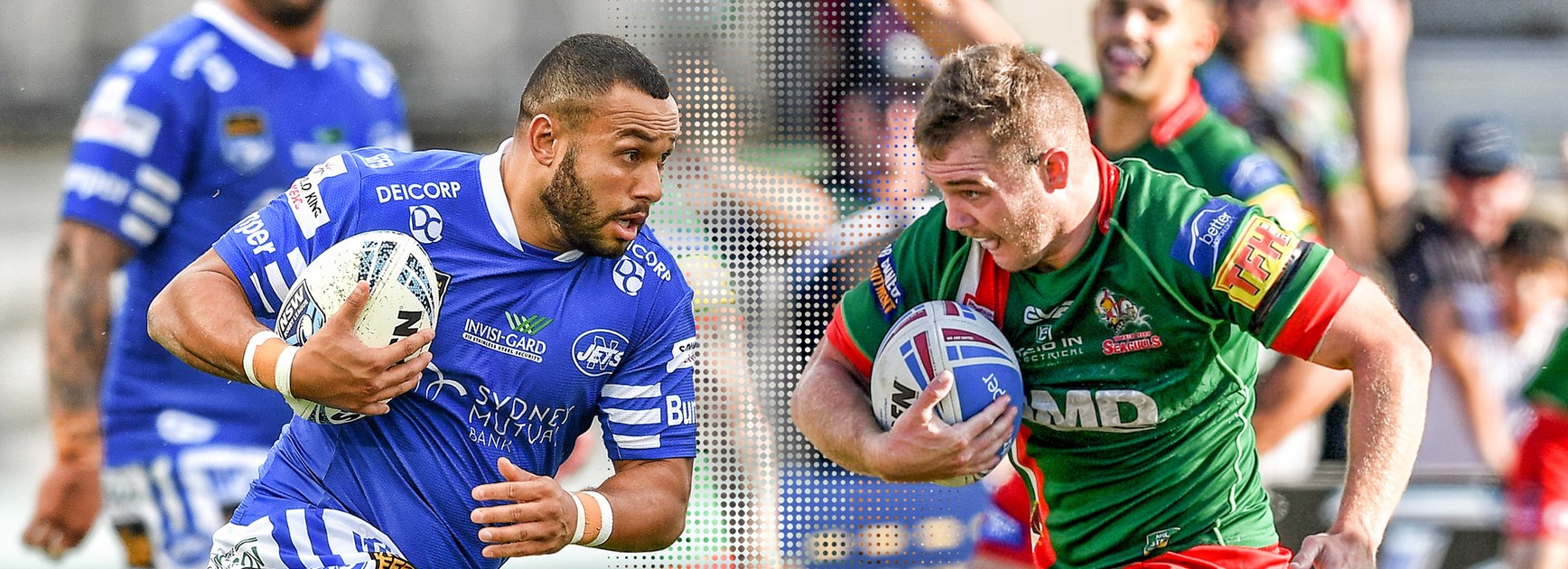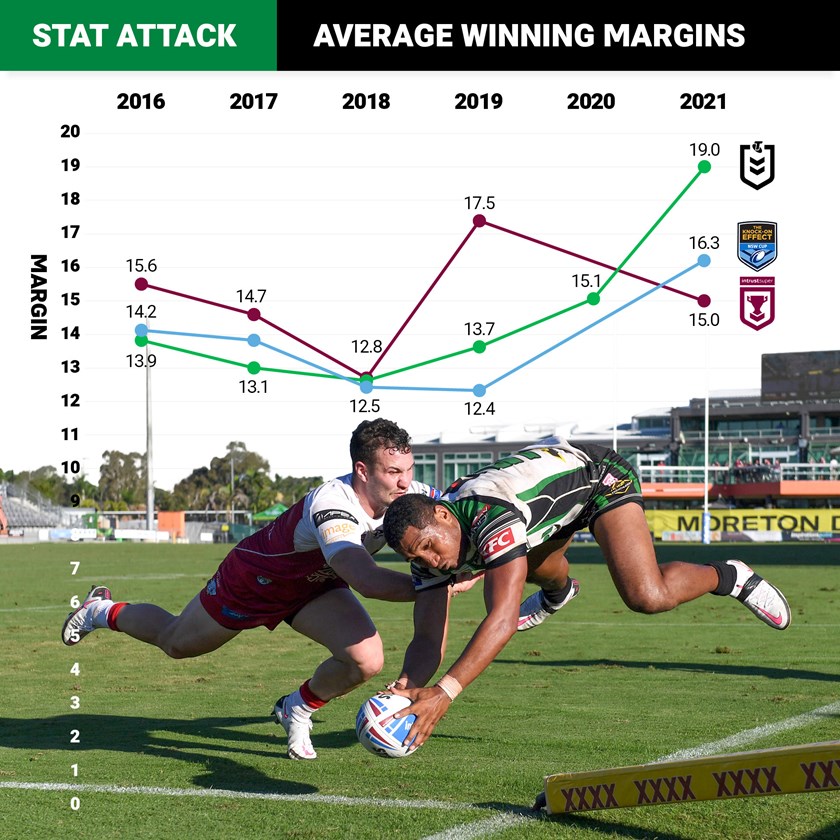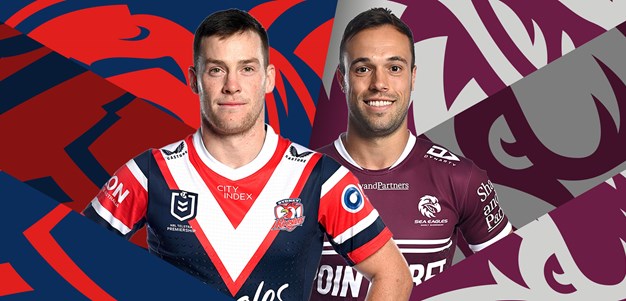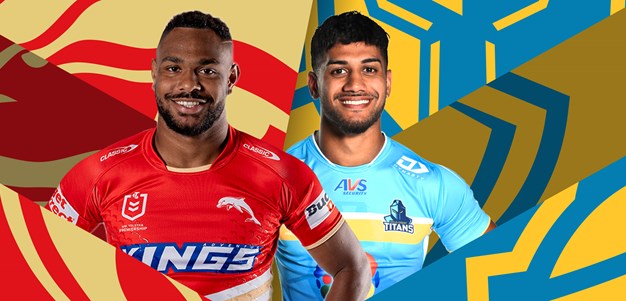
Melbourne are on track to surpass the 2001 Eels as the greatest attacking team in premiership history but the NRL trend of high scores and big winning margins isn’t being replicated in the NSW and Queensland Cup competitions despite both also adopting the six-again rule.
While blow-out scorelines in five of last weekend’s eight Telstra Premiership matches has prompted criticism of the six-again rule and questions about roster management at some NRL clubs, NSWRL and QRL officials have noticed little impact.
In fact, the average 15-point winning margin in Queensland’s Intrust Super Cup this season is less than before the introduction of the six-again rule, according to data provided by QRL and ABC Grandstand statistician Brad Tallon.
The increase in the NSWRL’s Knock-on Effect Cup compared to 2019 - the state competitions were suspended after one round last year due to the COVID-19 pandemic - has been significantly lower than in the NRL.
“It hasn’t affected our competitions at all in that way,” said Stuart Raper, the NSWRL’s high performance manager of referees. “We have had a number of draws, one-point games and two-point games.
“There has been a few high-scoring games but the teams in the NSW Cup are dictated by what is happening above them and you are getting some players coming up from Jersey Flegg or the Ron Massey Cup feeder teams so there are a lot of changes.

“I think the way we have implemented it as referees, we haven’t had those blowouts.”
Raper coached Cronulla for three seasons from 2004 after stints with Wigan and Castleford in the Super League and was involved when defences weren’t as dominant as they had become in the 16 years since Wests Tigers won the 2005 grand final with a free-wheeling attacking style.
The Eels scored a record 839 points in 2001 to claim the minor premiership from Newcastle, who finished the regular season with 782 points.
No team has scored as many points as either the 2001 Eels or Knights but the Storm are set to finish this season with 876 points if they continue to average 36.5 points per match in their remaining eight games.
Penrith are also on course to score more than 700 points – a feat not achieved since 2005, when the Eels scored 704 points.
Canterbury (760 points) and Sydney Roosters (710 points) exceeded that figure in 2004, as did the Bulldogs of 2003 (702 points) and 2002 (707 points), along with Newcastle (724 points).
“I really thought the game was going to break out and become more attacking because the Wests Tigers did play a different style but everyone then employed wrestling coaches, so it became defence orientated,” Raper recalled.
“I think the new rules have opened the game up a bit and I like that we have got away from structured attack. I know there are more blowouts but we [Cronulla] beat Manly by 68-6 in 2005 so there have always been blowouts.
Blues on the move
“It just happened that last Saturday there were three blowouts on the one night, but Manly are running hot at the moment with the best player in the game in Tom Trbojevic and they were playing a Bulldogs side that was decimated so we shouldn’t have been too surprised by the [66-0] result.”
However, Newcastle’s 2001 premiership-winning coach Michael Hagan believes the pendulum has swung too far in favour of attack and suggested teams of the early 2000s would have scored even more points under the six-again rule.
“Tommy Turbo [Trbojevic] is braining everyone. He is a fantastic player, but he has also got more time and space than he has ever had in his life to decimate opposition defensive lines, and that is even in State of Origin,” Hagan said of the Manly and NSW superstar.
“If you give more time and space to Andrew Johns, I think we [the Knights] would have scored more points.
Annesley explains Katoa knock-on decision
“The six-again is such a huge advantage for the attacking team. The Penrith-Parramatta game [last Friday night] was a contest because they are fairly evenly matched, but I think they need to wind it back. I think the players would be finding it unbelievably fatiguing in defence.”
Big bodies also driving change
Hagan watched Newcastle’s 1997 premiership-winning lock Marc Glanville interview rookie Knights winger Dom Young for Triple M after last Saturday night’s 38-0 thrashing of North Queensland and noticed that the 198cm tall teenager, who weighs 107kg, towered over him.
In comparison, Hagan’s 2001 premiership-winning team included forwards Glenn Grief, Clinton O’Brien, Paul Marquet and Daniel Abraham, who all stood at 185cm or shorter and weighed between 95kg and 102kg.
“The physics of the game now compared to 2001 are totally different,” Hagan said. “The game has developed so much in 20 years. Nelson Asofa-Solomona [200cm, 130kg) at the Storm is a giant of a man and he is athletic, mobile and fit.
“Some of our front-rowers would be punching out 20, 22 or sometimes 24 minutes maximum. Front-rowers now are knocking out the first half and some of them are doing 70 minutes - and they are big men in the middle.”
With wingers and centres now a similar size to forwards, many edge defences have been struggling this season.
Every try from Round 16
South Sydney winger Alex Johnston and Melbourne’s Josh Addo-Carr have both scored 19 tries in 16 matches and are vying to better the NRL record of 25 tries in a season held by Nathan Blacklock (Dragons 2001), Rhys Wesser (Panthers 2003) and Brett Morris (Dragons 2009).
“If you are an edge defender like a halfback or five-eighth, there is such a mis-match in the force required to stop that so you need three blokes because you can’t handle him with two,” Hagan said.
“You can’t win the play the ball, you can’t get back in the line, you can’t get your line set and you can’t get your numbers adjusted so you are pretty much stuffed.
“I think there has got to be more discretion shown by the referees because they wouldn’t have issued as many penalties under the same arrangements [as six-again calls].”
Graham Annesley weekly football briefing - Round 16
Rosters in transition
Rabbitohs coach Wayne Bennett suggested after Sunday’s defeat of Wests Tigers that rule changes weren’t as responsible for the disparity between teams as the way clubs were managed.
However, the increased speed of the game has forced some clubs to overhaul their rosters and it will take time to recruit or develop the type players they now want.
Mid-season transfers have increased this season, with 21 players having changed clubs since the start of the year and 38 having been released from contracts to play elsewhere since the 2020 grand final on October 25.
“I remember a coach’s meeting back in 2004 where they talked about bringing the interchange down from 12 to eight and [former Eels coach] Brian Smith put his hand up and said ‘hang on, we have recruited our players to suit a certain way we play’,” Raper said.
“I think now you can see that last year and this year clubs are starting to change their recruitment process and obviously their styles of play.
“There are certain players the rule changes have been good for and it is no surprise that someone like [Panthers playmaker] Jarome Luai has come to the fore as one of our better players in the game because the game is suited to his style of football.”
Veteran Manly five-eighth Kieran Foran also believes that the game may be in a transition phase and some clubs have been able to adapt to the changes quicker than others.
“I think the game is a great product at the moment,” Foran said. “The blowout scorelines aren't great but I'm not too sure what you can solely put that down to.
“The game wanted to go for that more entertaining and free-flowing look so it's the trade-off. As a game we wanted a more free-flowing and a high-paced game and we've got that. It's really suited for some teams and some players but not so much for others.”
The views in this article do not necessarily express the opinions of the NRL, ARLC, NRL clubs or state associations.





